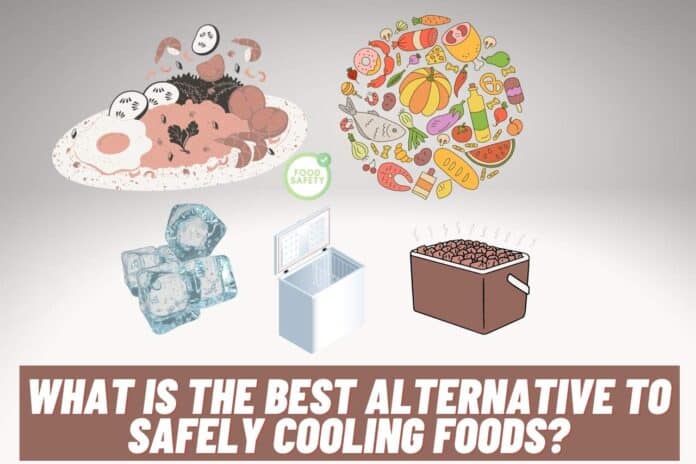Some of us have faced the unpleasant experience of food poisoning from a meal we had during our outings. Moreover, one of the main problems in food-related diseases is the wrong preservation methods used in freezing. What is the best alternative to safely cooling foods? We are going to discuss the fact here in this article.
Cooling in the refrigerator and freezing can be considered a common preservation method that has been used for over decades. Storing in the freezer will stop the natural spoiling process and the chemical reactions. Very low temperatures are also not favorable conditions for the activities of microorganisms. When freezing, the water content inside the food becomes ice, and as the microbes lack water for their biological activities, they will face a hard time surviving. Therefore, frozen foods can be kept for a long time without changing their texture, color, and taste.
What is the Best Alternative to Safely Cooling Foods?
In restaurants, the freezing method is widely used to offer a warm but quick dish according to the customer’s order. It is true that it increases the easiness and reduces wastage, but the freezing mechanism is not like just keeping the food inside the freezer. If you do not follow a proper guide to freeze the food, you will end in a disaster having food poisoning.
What is the best alternative to safely cooling foods? This is a must-touched area of general knowledge if you are a restaurant owner or are going to freeze some snacks for the family tea parties at your home. FDA (Food and Drug Administration) of the US has stated that two stages cooling process is the accurate way of freezing foods for consumption. We have described the method down below.
- The temperature danger zone for foods is considered in the range of 140°F – 41°F. In this range, there is a critical stage where we can see faster growth of bacteria, viruses, and fungus. The temperatures between 125°F – 70°F are the most dangerous zone. Surpassing these boundaries is a risky task. Don’t worry; if you follow the exact steps, your food will be reserved without any harm or risk.
- First, you have to cool the foods or the raw vegetables between 140°F – 70°F. When the foods reach the accurate temperatures, you must allow those to rest in that state for 2 hours. It is highly advised not to change these resting times.
- Then we are going to freeze it from 70°F – 41°F. You should do this within the next 4 hours after the first stage cooling. It does not matter if the temperature lies lower than 40°F. You can use a refrigerator-safe thermometer to check the temperature states from time to time to confirm the cooling levels. Normally, the price lies under $25.
- If you accidentally missed checking the temperature levels or face any trouble while freezing, you must not continue to the second cooling stage. Instead, you need to heat the foods to 165°F and keep them at that temperature for 15 seconds. After that, you can start the cooling again. But you need to wait until the foods become completely cooled.
- The most important thing here is to pay keen attention to the thermometer and do the two steps at the correct time. It is also crucial to keep the food separately in a few containers when kept in the freezer during these steps. Do not pack them all at once, and keep them inside the quick-freezing area of your fridge. After the freeze, you can pack them according to the desired amounts.
How to Cool Down Hot Foods?
Now, let’s see how to cool down our hot food before placing it in the fridge. The reason why we should not place foods in the fridge while they are hot since they can increase the temperature inside the fridge.
-
Ice Cube Method
You can put some cubes into your foods that possess a watery consistency. For instance, we can make soups, broths, stocks, and gravies. Here, there is nothing to be worried about regarding the thickness change, as you can adjust it again when you reheat the desired portion for consumption.
-
Ice Water Bucket Method
Here, instead of ice cubes, we use a bucket full of ice and water. Take a large basin and fill it with ice cubes and some water. Then take a pan with a matching depth and transfer your warm food to it. Place the pan inside but do not make it fully emerge. You can rotate the food container from time to time to let every side cool evenly. Measure the temperature decrement using a thermometer and maintain the temperature between the appropriate levels of the abovementioned steps. You can also use a water bucket at room temperature, but it will consume much more time than ice in the cooling process.
Allowing enough air to flow in the surroundings will also make the container cool rapidly. Open the windows switch on the fans, and make good ventilation.
-
Using a Blast Chiller
You can get the help of this rapid cooling system and cool your stuff more efficiently. If you are reading this topic for a commercial purpose, this is the ideal and practical method for you.
How to Reheat Frozen Foods?
When reheating, you can use a microwave or an oven for reheating purposes. Set the temperature to at least 60°C. Do not use other equipment like the air fryer as it may take a lot of time, and make a friendly time period for the growth of the microbes. You should keep watching on the temperature using a thermometer. If the food is unsafe to refreeze, consume it all at once. If there are leftovers, you will indeed have to throw them in the bin.
How to Package Frozen Foods?
If you are freezing a shop-bought item, its packaging would be enough. But if there are damages and holes in the cover, you can use plastic wrap and cover the entire item.
If you store frozen homemade items in the freezer, use double wrapping and place the single portions inside airtight containers.
Conclusion
Cooling food items for preservation should be done according to the correct methods to avoid food poisoning. We have discussed the approved method in this article.
Expand Your Horizons: More Content You Might Enjoy







![OGX Biotin And Collagen Shampoo Review [Updated One] Ogx Biotin And Collagen Shampoo Review](https://twinkyhome.com/wp-content/uploads/2022/03/Are-chicken-Super-Noodles-vegetarian-1-100x70.jpg)